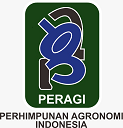Pengaruh Pemberian Pupuk Kalium terhadap Kualitas Dua Varietas Ubi Jalar (Ipomoea batatas L.)
Abstract
Indonesia, yang merupakan negara tropis, ubi jalar dapat tumbuh di hampir semua pulau di Indonesia. Ubi jalar memiliki berbagai varietas. Tanaman ubi jalar dikenal sangat responsif terhadap potasium. Diharapkan melalui penelitian ini akan diperoleh informasi tentang proporsi pupuk kalium yang tepat dalam setiap varietas yang diuji sehingga produktivitas tanaman ubi jalar dapat ditingkatkan. Eksperimen menggunakan Split Plot Design diulang tiga kali. Petak utama adalah Varietas (V), seperti Variasi Gunung Kawi dan Varietas Cilembu. Sub plot adalah Dosis KCl (K) yang terdiri dari 5 jenis seperti, K0 = 0 kg ha-1, K1 = 78 kg ha-1, K2 = 137 kg ha-1, K3 = 196 kg ha-1 dan K4 = 225 kg ha-1. Hasil observasi dianalisis dengan uji varians (uji F) pada level 5% dan 1%. Jika ada perbedaan yang signifikan, akan dilanjutkan dengan uji BNJ pada level 5% dengan korelasi dan uji regresi. Hasil penelitian menunjukkan, bahwa pemberian pupuk kalium dapat mempengaruhi kualitas dari tanaman ubi jalar kedua varietas. Pemberian kalium 225 kg ha-1 mampu meningkatkan kadar serat umbi sebesar 35% namun berdampak pada pengurangan kandungan klorofil sebesar 14%.
Keywords
Full Text:
PDFReferences
Anggraini, Y. D., & Sri, L. P. (2019). Interaksi Genotip x Lingkungan Beberapa Genotip Cabai Rawit (Capsicum frutescens L.) di Dua Lokasi. J. Produksi Tanaman, 7(8), 1574–1580. http://protan.studentjournal.ub.ac.id/index.php/protan/article/view/1212
Bolan, N. S., L., P., & Surinder, S. (2005). Encyclopedia of Soils in the Environment (pp. 149–154).
Broxterman, S. E., & Schols, H. A. (2018). Interactions between pectin and cellulose in primary plant cell walls. Carbohydrate Polymers, 192, 263–272. https://doi.org/10.1016/j.carbpol.2018.03.070
Dhingra, D., Michael, M., Rajput, H., & Patil, R. T. (2012). Dietary fibre in foods: a review. Journal of Food Science and Technology, 49(3), 255–266. https://doi.org/10.1007/s13197-011-0365-5
Ding, Y. C., Chang, C.-R., Lou, W., Wu, Y.-S., Ren, X.-L., Wang, P., & Xu, G.-H. (2008). High Potassium Aggravates the Oxidative Stress Inducedy by Magnesium Deflciency in Rice Leaves. Pedosphere, 18(3), 316–327. https://doi.org/10.1016/S1002-0160(08)60021-1
Ding, Y., Luo, W., & Xu, G. (2006). Characterisation of magnesium nutrition and interaction of magnesium and potassium in rice. Annals of Applied Biology, 149(2), 111–123. https://doi.org/10.1111/j.1744-7348.2006.00080.x
Franco, A. (2016). Characterization of Sweet Potato (Ipomoea batatas L.) Starch From Two Clones and Evaluation of Its Properties For Industrial Uses. Conference: AIChe Annual Meeting.
George, J., Kalidas, P., Arup, K. M., & Archana, M. (2015). High Starch, Low Sugar Yielding Genotypes of Sweet Potato and their Micropropagation. IJTA, 33, 401–404. https://www.cabdirect.org/cabdirect/abstract/20153325945
Julio Suhardi, C., Ratnawati, R., & Khotimah, H. (2016). Pengaruh Pemberian Antosianin dari Ipomoea batatas L.Varietas Ungu Kultivar Gunung Kawi dalam Meningkatkan Kadar Superoxide Dismutase pada Tikus (Rattus norvegicus) dengan Diet Aterogenik. Majalah Kesehatan, 3(4), 166–173. https://doi.org/10.21776/ub.majalahkesehatan.003.04.1
Jusuf, M., & Ginting, E. (2014). The Prospects and Challenges of Sweet Potato as Bio-ethanol Source in Indonesia. Energy Procedia, 47, 173–179. https://doi.org/10.1016/j.egypro.2014.01.211
Pushpalatha, M., Vaidya, P. H., & Adsul, P. B. (2017). Effect of Graded Levels of Nitrogen and Potassium on Yield and Quality of Sweet Potato (Ipomoea batatas L.). International Journal of Current Microbiology and Applied Sciences, 6(5), 1689–1696. https://doi.org/10.20546/ijcmas.2017.605.183
Saitama, A., Nugroho, A., & Widaryanto, E. (2017). Yield response of ten varieties of sweet potato (Ipomoea batatas L.) cultivated on dryland in rainy season. Journal of Degraded and Mining Lands Management, 04(04), 919–926. https://doi.org/10.15243/jdmlm.2017.044.919
Simo, C., Nono, G. V., & Taffouo, V. D. (2017). Evaluation of different sweet potato varieties for growth, quality and yield traits under chemical fertilizer and organic amendments in sandy ferralitic soils. African Journal of Agricultural Research, 12(48), 3379–3388. https://doi.org/10.5897/AJAR2017.12675
Stone, M., Martyn, L., & Weaver, C. (2016). Potassium Intake, Bioavailability, Hypertension, and Glucose Control. Nutrients, 8(7), 444. https://doi.org/10.3390/nu8070444
Subaedah, S., Aladin, A., & Nirwana. (2016). Fertilization of nitrogen, phosphor and application of green manure of Crotalaria juncea in increasing yield of maize in marginal dry land. Agriculture and Agricultural Science Procedia, 9, 20–15.
Trustinah, & Iswanto, R. (2013). Pengelompokan Aksesi Kacang Hijau Berdasarkan Karakter Kuantitatif. Prosiding Seminar Nasional Hasil Penelitian Tanaman Aneka Kacang Dan Umbi, 7–14.
Zaidiyah. (2014). Sucrose, Reducing Sugars, and Carotenoid Content of Aceh Besar Sweet Potato Cultivars (Ipomoea batatas L.). J. Teknologi Dan Industri Pertanian Indonesia, 6(1), 13–16. https://doi.org/https:doi: https://doi.org/10.17969/jtipi.v6i1.1984
Zhang, W., Chen, X.-X., Liu, Y.-M., Liu, D.-Y., Du, Y.-F., Chen, X.-P., & Zou, C.-Q. (2018). The role of phosphorus supply in maximizing the leaf area, photosynthetic rate, coordinated to grain yield of summer maize. Field Crops Research, 219, 113–119. https://doi.org/10.1016/j.fcr.2018.01.031
Refbacks
- There are currently no refbacks.



























